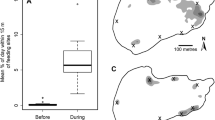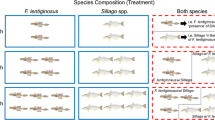Abstract
The foraging behavior of pale chub, Zacco platypus in experimental ponds was observed and the fish were classified according to whether they predominantly employed near-bed cruising and bottom feeding (type B) or whether they exhibited sit-and-wait and near-surface cruising, with occasional drift and surface feeding (type S). Fish that exhibited both behaviors were classified as type I. The effects of pale chub on trophic cascades were examined in pools into which river water was pumped. Twenty pools were assigned to four treatments and contained either no fish, or six pale chub of type B, or of type I, or of type S. Fish behavior was consistent throughout the experiments, and was not related to body length or sex. All types of pale chub predominantly preyed on invertebrates, but type B consumed more benthic algae than did type S. The algal biomass in pools with types S and I was greater than that in pools without pale chub as a result of trophic cascades. In pools with type B fish, the number of algal-grazing invertebrates on the upper surface of tiles was reduced as in pools with types S and I, but algal biomass did not increase because of direct grazing by type B fish. The mechanisms of reduction of algal-grazing invertebrates were different between types B and S; type S predominantly preyed on invertebrates in the water current, whereas type B preyed on and threatened invertebrates on the upper surface of tiles and removed them. Individual differences in foraging mode had significant effects on the mechanism of trophic cascades.







Similar content being viewed by others
References
Abrams PA (1990) The evolution of anti-predator traits in prey in response to evolutionary change in predators. Oikos 59:147–156
Beverly BD, McLendon H, Nacu S, Holmes S, Gordon DM (2009) How site fidelity leads to individual differences in the foraging activity of harvester ants. Behav Ecol 20:633–638
Bolnick DI, Svanbäck R, Fordyce JA, Yang H, Davis JM, Hulsey CD, Forister ML (2003) The ecology of individuals: incidence and implications of individual specialization. Am Nat 16:1–28
Budaev SV, Zworykin DD (2002) Individuality in fish behavior: ecology and comparative psychology. J Ichthyol 42(Supple 2):S189–S195
Carpenter SR, Kitchell JF, Hodgson JR (1985) Cascading trophic interactions and lake productivity. Bioscience 35:634–639
Clark AB, Ehlinger TJ (1987) Pattern and adaptation in individual behavioral differences. In: Bateson PPG, Klopfer PH (eds) Perspectives in ethology, vol 7. Plenum Press, New York, pp 1–47
Dall SRX, Cuthill LC (1997) The information costs of generalism. Oikos 80:197–202
Dall SRX, Houston AI, McNamara JM (2004) The behavioral ecology of personality: consistent individual differences from an adaptive perspective. Ecol Lett 7:734–739
Diehl S (1993) Relative consumer sizes and the strengths of direct and indirect interactions in omnivorous feeding relationships. Oikos 68:151–157
Endler JA (1986) Defense against predators. In: Feder ME, Lauder GV (eds) Predator-prey relationships. University of Chicago Press, Chicago, pp 109–134
Flecker AS, Taylor BW (2004) Tropical fishes as biological bulldozers: density effects on resource heterogeneity and species diversity. Ecology 85:2267–2278
Gerking SD (1994) Feeding ecology of fish. Academic, San Diego
Giller PS, Malmqvist B (1998) The biology of streams and rivers. Oxford University Press, Oxford
Hill WR, Knight AW (1987) Experimental analysis of the grazing interaction between a mayfly and stream algae. Ecology 68:1955–1965
Hill WR, Boston HL, Steinman AD (1992) Grazers and nutrients simultaneously limit lotic primary productivity. Can J Fish Aquat Sci 49:504–512
Katano O (1987) Social structure of the dark chub, Zacco temmincki, in a small pond in relation to individual differences. Physiol Ecol Japan 24:1–132
Katano O (1994) Aggressive interactions between the dark chub, Zacco temmincki, and the pale chub, Zacco platypus, in relation to their feeding behavior. Jpn J Ichthyol 40:441–449
Katano O (1996) Foraging tactics and home range of dark chub in a Japanese river. Oecologia 106:199–205
Katano O (2007) Effects of experimental duration and density of Japanese dace Tribolodon hakonensis on the strength of trophic cascades on benthic algae. Oecologia 154:195–205
Katano O, Aonuma Y (2001) Negative effect of ayu on the growth of omnivorous pale chub in experimental pools. J Fish Biol 58:1371–1382
Katano O, Aonuma Y, Nakamura T, Yamamoto S (2003) Indirect contramensalism though trophic cascades between two omnivorous fishes. Ecology 84:1311–1323
Katano O, Nakamura T, Yamamoto S (2006) Intraguild indirect effects through trophic cascades between stream-dwelling fishes. J Anim Ecol 75:167–175
Katano O, Nakamura T, Abe S (2008) Indirect effects of the algivorous fish Plecoglossus altivelis altivelis on the growth of two insectivorous fish. Freshw Biol 53:1345–1358
Kitchell JF, O’Neill RVO, Webb D, Gallapp GW, Bartell SM, Koonce JF, Ausmus BS (1979) Consumer regulation of nutrient cycling. Bioscience 29:28–34
Minderman J, Reid JM, Evans PGH, Whittingham M (2009) Personality traits in wild starlings: exploration behavior and environmental sensitivity. Behav Ecol 20:830–837
Miner BG, Sultan SE, Morgan SG, Padilla DK, Relyea RA (2005) Ecological consequences of phenotypic plasticity. Trends Ecol Evol 20:685–692
Mizuno N, Kawanabe H, Miyadi D, Mori S, Kodama H, Ohgushi R, Kusakabe A, Huruya Y (1958) Life history of some stream fishes with special reference to four cyprinid species. Cont Lab Physiol Ecol Kyoto Univ 81:1–48 (in Japanese)
Møller A, Balbontín J, Cuervo JJ, Hermosell IG, de Lope F (2009) Individual differences in protandry, sexual selection, and fitness. Behav Ecol 20:433–440
Nakano S, Furukawa-Tanaka T (1994) Intra- and Inter-specific dominance hierarchies and variation in foraging tactics of two species of stream-dwelling chars. Ecol Res 9:9–20
Nakano S, Miyasaka H, Kuhara N (1999) Terrestrial aquatic linkages: riparian arthropod inputs alter trophic cascades in a stream food web. Ecology 80:2435–2441
Otto SB, Berlow EL, Rank NE, Smiley J, Brose U (2008) Predator diversity and identity drive interaction strength and trophic cascades in a food web. Ecology 89:134–144
Palkovacs EP, Post DM (2009) Experimental evidence that phenotypic divergence in predators drives community divergence in prey. Ecology 90:300–305
Partridge L, Green P (1985) Intraspecific feeding specializations and population dynamics. In: Sibly RM, Smith RH (eds) Behavioural ecology: ecological consequences of adaptive behavior. Blackwell Scientific Publications, Oxford, pp 207–226
Polis GA (1984) Age structure component of niche width and intraspecific resource partitioning: can age groups function as ecological species? Am Nat 123:541–564
Power ME (1992a) Habitat heterogeneity and the functional significance of fish in river food webs. Ecology 73:1675–1688
Power ME (1992b) Top-down and bottom-up forces in food webs: do plants have primacy? Ecology 73:733–746
Power ME, Matthews WJ (1983) Algae-grazing minnows (Compostoma anomalum), piscivorous bass (Micropterus spp.), and the distribution of attached algae in a small prairie-margin stream. Oecologia 60:328–332
Ringler NH (1983) Variation in foraging tactics of fishes. In: Noakes DLG, Lindquist DG, Helfman GS, Ward JA (eds) Predators and prey in fishes. Junk, The Hague, pp 159–172
Rosemond AD, Mulholland PJ, Elwood JW (1993) Top-down and bottom-up control of stream periphyton: effects of nutrients and herbivores. Ecology 74:1264–1280
Roughgarden J (1972) Evolution of niche width. Am Nat 106:683–718
Rudolf VHW (2007) Consequences of stage-structured predators: cannibalism, behavioral effects, and trophic cascades. Ecology 88:2991–3003
Schmitz OJ, Krivan V, Ovadia O (2004) Trophic cascades: the primacy of trait-mediated indirect interactions. Ecol Lett 7:153–163
Shurin JB, Borer ET, Seabloom EW, Anderson K, Blanchette CA, Broitman B, Cooper SD, Halpern BS (2002) Across-ecosystem comparison of the strength of trophic cascades. Ecol Lett 5:785–791
Steinman AD, Lamberti GA (1996) Biomass and pigments of benthic algae. In: Hauer FR, Lamberti GA (eds) Method in stream ecology. Academic, San Diego, pp 295–313
Strong DR (1992) Are trophic cascades all wet? Differentiation and donor control in a speciose system. Ecology 73:747–754
Swanson B, Gibb AC, Marks JC, Hendrickson DA (2003) Trophic polymorphism and behavioral differences decrease intraspecific competition in a cichlid, Herichthys minckleyi. Ecology 84:1441–1446
Townsend CR (2003) Individual, population, community, and ecosystem consequences of a fish invader in New Zealand streams. Conserv Biol 17:38–47
Wootton JT (1994) The nature and consequences of indirect effects in ecological communities. Ann Rev Ecolog Syst 25:443–466
Acknowledgements
The author would like to thank Fukashi Onuma, Ayumi Ishihara and Keiko Kurosawa for their help during experiments, and Josho Fishermen’s Union for permission to capture pale chub. The present study observed all Japanese laws of animal experimentation and welfare. This work was supported by the Grant-in-Aid for Scientific Research (C) (20570028, 22570018) from Japan Society for the Promotion of Science and Ministry of Education, Culture, Sports, Science and Technology of Japan.
Author information
Authors and Affiliations
Corresponding author
Rights and permissions
About this article
Cite this article
Katano, O. Effects of individual differences in foraging of pale chub on algal biomass through trophic cascades. Environ Biol Fish 92, 101–112 (2011). https://doi.org/10.1007/s10641-011-9820-4
Received:
Accepted:
Published:
Issue Date:
DOI: https://doi.org/10.1007/s10641-011-9820-4




